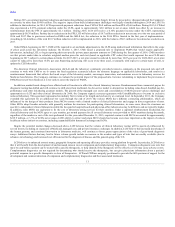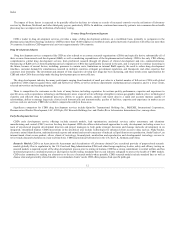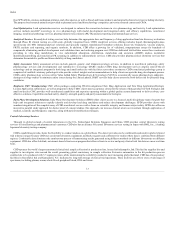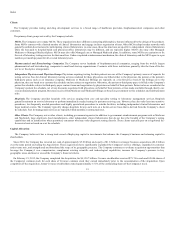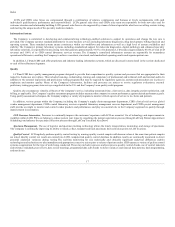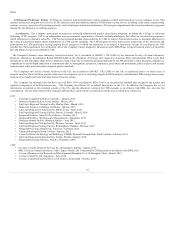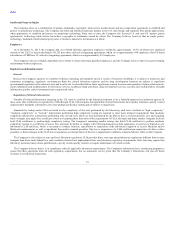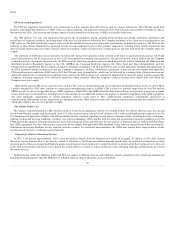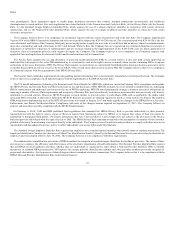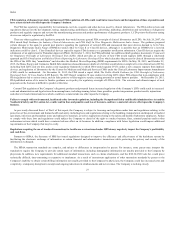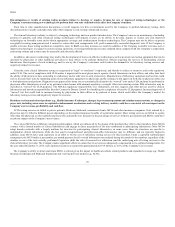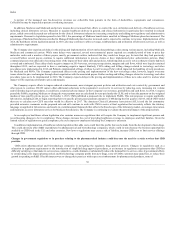LabCorp 2015 Annual Report Download - page 21
Download and view the complete annual report
Please find page 21 of the 2015 LabCorp annual report below. You can navigate through the pages in the report by either clicking on the pages listed below, or by using the keyword search tool below to find specific information within the annual report.
Index
to Medicaid recipient. Laboratories primarily bill and are reimbursed by Medicare and Medicaid directly for covered tests performed on behalf of Medicare
and Medicaid beneficiaries; for beneficiaries that participate in Managed Medicare and Managed Medicaid plans, laboratory bills are submitted to and paid
by MCOs who manage those plans.
As discussed previously in Item 1 of Part I, over the past several years LCD has experienced a series of reductions in payment from Medicare, and it
expects to experience continued reductions through 2016 and 2017. However, rulemaking to implement PAMA has not yet been finalized, and the methods
to be used by CMS to establish fees for laboratory services under the CLFS are not yet determined. Until those rules are final, the Company cannot assess the
impact of further fee changes pursuant to PAMA.
Many pathology services performed by LCD are reimbursed by Medicare under the PFS. The PFS assigns relative value units to each procedure or service,
and a conversion factor is applied to calculate the reimbursement. The PFS is also subject to adjustment on an annual basis. Such adjustments can impact
both the conversion factor or relative value units. The Sustainable Growth Rate (SGR), the formula formerly used to calculate the fee schedule conversion
factor, would have resulted in significant decreases in payment for most physician services for each year since 2003. However, Congress intervened
repeatedly to prevent these payment reductions, and the conversion factor was increased or frozen for the subsequent year. MACRA permanently replaced the
SGR formula and transitioned PFS reimbursement to a value-based payment system. MACRA retroactively avoided a 21.2% reduction in PFS reimbursement
that had been scheduled for April 1, 2015, and provided for PFS conversion factor increases of 0.5% from July 1, 2015 to December 31, 2015, and 0.5% in
each of years 2016-2019, followed by 0.0% updates for 2020-2025, and updates that vary based on participation in alternative payment models in
subsequent years. These changes to the conversion factor may be offset by reductions to the relative value units, as was the case with the 2016 PFS
reductions. In addition, rates will be adjusted under the new Merit-Based Incentive Payment System beginning in 2019. Approximately 0.9% of LCD's
revenue is reimbursed under the PFS.
Because a significant portion of the Company's costs are relatively fixed, further payment reductions to Medicare, Medicaid and other government
programs could have a direct adverse effect on the Company's net earnings and cash flows. The Company cannot predict whether changes will be
implemented that will result in further payment reductions.
In addition to changes in reimbursement rates, LCD is also impacted by changes in coverage policies for laboratory tests. Congressional action in 1997
required HHS to adopt uniform coverage, administration and payment policies for many of the most commonly performed lab tests using a negotiated
rulemaking process. The negotiated rulemaking committee established uniform policies limiting Medicare coverage for certain tests to patients with
specified medical conditions or diagnoses, replacing local Medicare coverage policies which varied around the country. Since the final rules generally
became effective in 2002, the use of uniform policies has improved LCD's ability to obtain necessary billing information in some cases. However, Medicare,
Medicaid and private payer diagnosis code requirements and payment policies continue to negatively impact LCD's ability to be paid for some of the tests it
performs. LCD also experienced delays in the pricing and implementation of new molecular pathology codes among various payers, including Medicaid,
Medicare and commercial carriers. While some delays were expected, several non-commercial payers required an extended period of time to price key
molecular codes and a number of those payers, mostly government entities, indicated that they would no longer pay for tests that they had previously
covered. Further, several payers continue to require additional information to process claims or have implemented prior authorization policies. Many
commercial payers were delayed in becoming aware of the impact of their claim edits and policies which impeded access to services that previously have
been covered and reimbursed. These issues had a negative impact on revenue, revenue per requisition, margins and cash flows, which were largely sustained
in the years 2013 through 2015, and are expected to have a continuing negative impact. Similarly, CLFS coding and billing changes related to toxicology
and other procedures were implemented in 2015 and Palmetto implemented a revised Drugs of Abuse Local Coverage Policy which impacted the handling of
such procedures for Medicaid and MCOs. The Company experienced delays in the pricing and implementation of the new toxicology codes, however,
largely overcame issues related to price and margins through direct negotiation with the associated payers. Further coding and billing changes related to
toxicology testing and other procedure types are to be implemented in 2016. The Company expects delays in the pricing and implementation of these new
codes and it is unclear what impact will be experienced related to price and margins.
Future changes in national, state and local laws and regulations (or in the interpretation of current regulations) affecting government payment for clinical
laboratory testing could have a material adverse effect on the Company. Based on currently available information, the Company is unable to predict what
type of changes in legislation or regulations, if any, will occur.
In the U.S., the Health Insurance Portability and Accountability Act of 1996 (HIPAA) was designed to address issues related to the security and
confidentiality of health information. In an effort to improve the efficiency and effectiveness of the healthcare system by facilitating the electronic exchange
of information in certain financial and administrative transactions, HIPAA regulations
21


